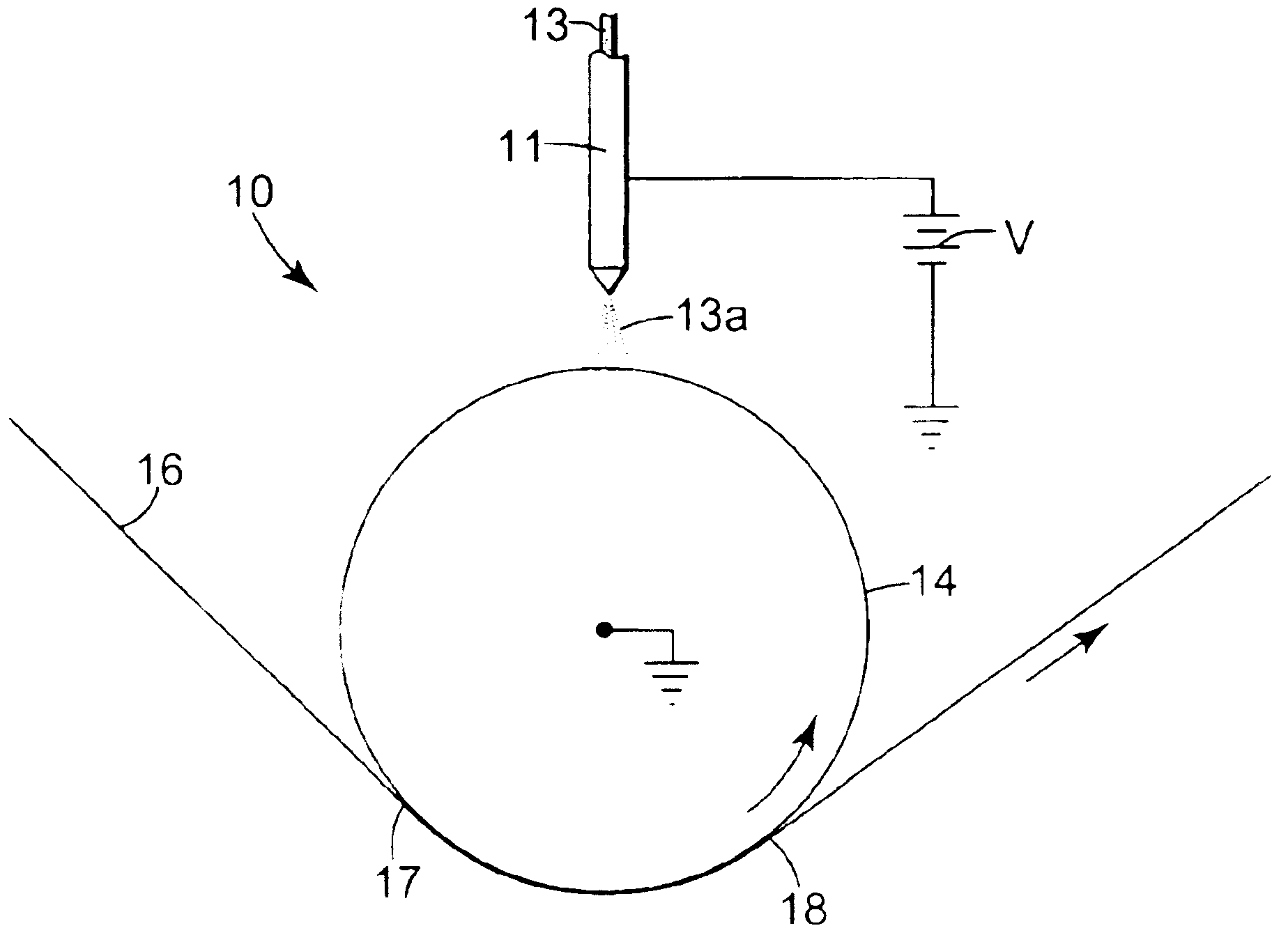Electrostatic spray coating apparatus and method
a technology of electrostatic spraying and coating apparatus, which is applied in the direction of electrostatic spraying apparatus, coatings, electric shock equipment, etc., can solve the problems of voids in the coating, adversely affecting the final coating's other desired properties, and so as to improve the uniformity of the coating on the substrate, reduce the time required for drops to coalesce into the coating, and improve the effect of coating uniformity
- Summary
- Abstract
- Description
- Claims
- Application Information
AI Technical Summary
Benefits of technology
Problems solved by technology
Method used
Image
Examples
example 1
[0100]A 35 micrometer thick, biaxially oriented polypropylene (BOPP) web that had been flame treated on its upper side (Douglas-Hanson Company) was passed over two 7.62 cm diameter idler rolls. The idler rolls had been separated in the machine direction by a sufficient distance to allow a 50.8 cm diameter by 61 cm wide grounded stainless steel drum to be dropped in place between the idler rolls. This caused the web to contact approximately one-half the circumference of the drum and forced the drum to co-rotate at the 15.2 m / min surface speed of the moving web. A solventless silicone acrylate UV curable release formulation like that of Example 10 of U.S. Pat. No. 5,858,545 was prepared and modified by the addition of 0.3 parts per hundred (pph) of 2,2′-(2,5-Thiophenediyl)bis[5-tert-butylbenzoxazole] (UVITEX™-OB fluorescing dye, Ciba Specialty Chemicals Corp.)
[0101]An electrostatic spray head that could operate in the electrospray mode like that of U.S. Pat. No. 5,326,598 was modified...
example 2
[0103]The apparatus of Example 1 was modified by installing a nip roll that pressed against the underside of the drum at the initial coating line where the liquid first contacted the web. Except for two locations where small gouges (indentations) were present on the nip roll, use of the nip roll eliminated all uncoated areas on the web, and provided a coating having visually improved uniformity. The improved uniformity could be verified by shining a Model 801 “black light” fluorescent fixture (Visual Effects, Inc.) on the wet coating. The UVITEX™ OB fluorescing dye in the release coating radiates blue light under such illumination, and provided a readily discernable illustration of the amount and uniformity of the thin coating deposited the web.
example 3
[0104]The apparatus of Example 1 was modified by adding an eight roll improvement station after the second idler roll, and routing the coated web through the improvement station so that the wet side of the web contacted the eight pick-and-place rolls as shown in FIG. 3a. The eight rolls had respective diameters of 54.86, 69.52, 39.65, 56.90, 41.66, 72.85, 66.04, and 52.53 mm, all with a tolerance of plus or minus 0.025 mm. The rolls were obtained from Webex Inc. as dynamically balanced steel live shaft rolls with chrome plated roll faces finished to 16 Ra. The improvement station eliminated all uncoated areas on the web, including the gouge marks caused by the indentations on the nip roll, and provided a coating having further visually improved uniformity when evaluated using black light illumination.
PUM
 Login to View More
Login to View More Abstract
Description
Claims
Application Information
 Login to View More
Login to View More - R&D
- Intellectual Property
- Life Sciences
- Materials
- Tech Scout
- Unparalleled Data Quality
- Higher Quality Content
- 60% Fewer Hallucinations
Browse by: Latest US Patents, China's latest patents, Technical Efficacy Thesaurus, Application Domain, Technology Topic, Popular Technical Reports.
© 2025 PatSnap. All rights reserved.Legal|Privacy policy|Modern Slavery Act Transparency Statement|Sitemap|About US| Contact US: help@patsnap.com



